Home Invasion, Baboon-style
Air Date: Week of March 16, 2007
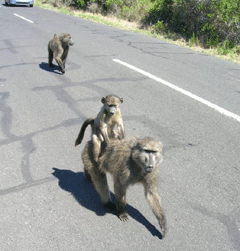
Baboons on the move as monitors drive them from the villages. (Photo: Terry FitzPatrick)
There’s a battle underway in the suburbs of Cape Town, South Africa: people versus baboons. Troupes of baboons are roaming suburban neighborhood streets, looking for food and scaring residents. In some cases, they’ve broken windows and locks to raid kitchen cabinets. As host Steve Curwood reports, there’s fierce debate over how best to keep the baboons away from people.
Transcript
CURWOOD: Increasingly, people who live at the edges of American cities are having close encounters with some big wild animals. It can be a coyote in the park a bear in a dumpster maybe even a cougar on a jogging trail. But of course the problem isn’t unique to the U.S.
[BABOON SOUNDS]
Here in the foothills outside of Cape Town, South Africa, suburban development is leading to more and more conflicts between people and baboons.
[BABOON SOUNDS]
MARRIOTT: In the winter they seem to stop coming ‘round the streets. But in the summer they’re everywhere.
[BABOON SOUNDS]
VENTER: Baboons are fine in their own environment, I know. And I used to love the baboons. I don’t feel the same way anymore.
[BABOON SOUNDS]
JAMES: They’re not domestic animals. It’s not like having a cat or a dog. A baboon is a wild animal. And he lives accordingly. And if you get in his way, if you get in the way and if you corner a big male, he’s going to go for you.
CURWOOD: Residents of Welcome Glen enjoy a tranquil village life, with picturesque views of the ocean and the Cape of Good Hope. But on garbage collection days, the streets here can be chaos.
[HOSE SOUNDS]
CURWOOD: Chris Schulz rolls out his garden hose.
SCHULZ: We just hose them. They are scared of water. On dirt day they come out and they’re a menace.
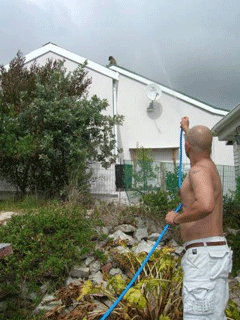
Welcome Glen resident Chris Schulz sprays water to scare a baboon off the roof. (Photo: Terry FitzPatrick)
[HOSE SOUND]
CURWOOD: Curbside trash bins provide an easy meal. Baboons tip them over to nibble on table scraps.
[SCREECH SOUND]
CURWOOD: With piercing, deep-set eyes, rounded snouts, and wiry gray fur, the animals look like tough guys. A fully-grown male can weigh a hundred pounds. Rob and Elizabeth Venter have a slingshot ready as the troupe moves their way.
R. VENTER: That’s “George.”
E. VENTER: No it’s not “George,” it’s “Eric.”
R. VENTER: Well it’s either “George” or “Eric.” It’s one of the two alpha baboons. They’re really big and they attack you. One time one of my friends held up a big stick to it, and “George” grabbed it out of his hand and chased him down the road with the stick.
CURWOOD: Baboons have long foraged in gardens and garbage dumps. But in recent years, animals like “George” have grown more adventurous, seeking supper inside people’s homes.
E. VENTER: He’s very aggressive. And he came into my back sliding door, and suddenly he was right there on my kitchen counter in front of me. And I just said: “go, go” like that. And he went: “argh” to me.
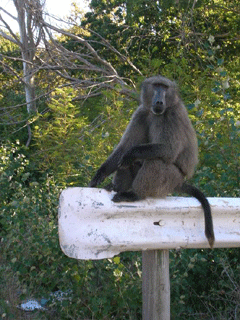
Baboons looking at the village, ready to raid!
(Photo: Terry FitzPatrick)
E. VENTER: No, I jumped back, then I ran out of the house, and called for help. And a neighbor came in with a shovel and he went out. But it was very, very scary.
[DOG BARKING]
CURWOOD: Welcome Glen is one of several neighborhoods battling the baboons. A dozen troupes with more than 350 animals live in nature preserves on the outskirts of Cape Town. The troupes vary in size from one-dozen to three-dozen members, and not all of them raid nearby homes. But everyone living near the parks has a tale to tell.
VOLBRECHT: Well they’ve cost us 25,000 rands in repairs to this house. On the back side, there’s a roof that they’ve broken through. They ended up inside the house in the ceiling.
CURWOOD: Now, more than three thousand U.S. dollars later, Carlo Volbrecht has concluded that many of the animals have grown comfortable in both natural and human environments.
VOLBRECHT: Baboons have become so used to people. And the problem is when they get that relaxed around people, they chase you away from your barbecue in the back, help themselves, and then leave when they’re done. And you’ve go to sit inside your house looking at them.
[WHISTLING AND CLAPPING SOUNDS MAN YELLING]
CURWOOD: The growing conflict between people and baboons has prompted a new type of neighborhood watch. Teams of trained wranglers now respond to baboon raids. They help people cope and also try to keep the primates out of trouble.
[WRANGLING SOUNDS]
CURWOOD: By clapping, shouting and whistling, this three-man team begins to nudge the troupe out of the village and into a grove of pine trees.
MJEMBU: We make a noise like: whoah, whistle, whistle. They know what’s going on. They must go. Whoah, whoah, go, go, whoa, whoah.
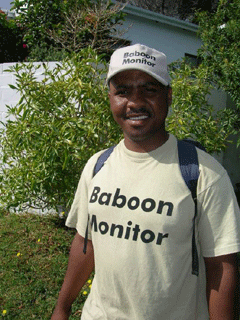
Jerry Mjembu is a monitor for Baboon Matters. (Photo: Terry FitzPatrick)
CURWOOD: On this morning Jerry Mjembu is having a tough time. The problem: a female nestled high in a tree, cradling a tiny bundle of fur.
[MOM & BABE BABOON]
MJEMBU: She got a new baby.
CURWOOD: Ahh.
MJEMBU: Yeah, this morning.
[EATING PINE NUTS]
CURWOOD: The troupe will not leave a mother and newborn behind, though most members eventually settle into the forest to eat pine nuts while the monitoring team guards the village. Eighteen trackers are now working as part of this wildlife management project. It’s funded by a public-private partnership, and run by an animal welfare organization called “Baboon Matters.” The founder is conservationist Jenni Trethowan.
TRETHOWAN: Baboons are highly, highly intelligent creatures. So a lot of the conflict is because they very quickly suss out a situation. So if the rewards are high they’ll take the risk. And of course, as more and more people are moving into their areas they are sussing out that there’s easy food to be gotten from humans, either through our waste or through fruit trees or through gaining entry to houses. So there’s still plenty of food for the remaining baboons on the mountains, but it’s just much easier for them to come down into the villages, which has always been in their home ranges and their forage areas and get much easier food.
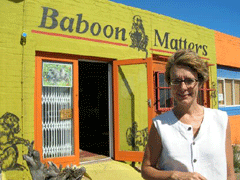
Conservationist Jenni Trethowan monitors baboons from her office in Cape Town suburbs. (Photo: Terry FitzPatrick)
CURWOOD: Now, what do we know about the culinary tastes of baboons? What do they like in the wild, and then what do like when they get the people food?
TRETHOWAN: They’ve got an incredibly diverse range of tastes. Um, here we can see them this morning they’ve been eating the pine nuts. So they make use of about 250 to 260 different plants on the mountain. That’s everything from the bulbs, the roots, the leaves, the flowers of certain species. And now you’ll see them catching insects, very quickly.
When they come into the village, basically most of our human foods. You’ll see if they get into a kitchen they’ll go through the ranges quite quickly. One of our young male baboons has been named spaghetti by the monitors and that’s because he has a real love of spaghetti. (laughs) So they’ve definitely got taste preferences but they’re very adaptable.
[BABOON SOUNDS]
[WRANGLING SOUNDS]
CURWOOD: The monitors work year-round to herd the animals away from people in the first place. Statistics show they’ve been remarkably effective. But they can’t be everywhere, and Trethowan says hundreds of homes have been invaded. There’ve been newspaper stories about baboons confronting diners at local restaurants, and mauling a four-year old boy at a campground.
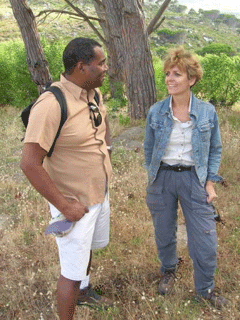
Steve Curwood and Jenni Trethowan hang out with the baboons. (Photo: Terry FitzPatrick)
[BABOON WALK FOOTFALLS]
CURWOOD: While the monitor teams continue their work to keep baboons in the wild, the Baboon Matters project has launched an effort to prove that wildlife can benefit the local economy.
MANELI: So what is going to happen when we come up there to the baboons, maybe the baboons are going to fight. There is nothing they are going to do with us. They are going to do their thing.
CURWOOD: This is baboon tourism. Small groups of visitors are guided into the hills for a two-hour intimate experience. The guide is Siphelo Maneli who says his mother’s tribal name means “female baboon.” He regards the animals as cousins.
[BABOON SOUNDS]
MANELI: This is “Georgie,” the alpha male of this group. As you can see, the old man is surrounded by family. We can come up.
[WALKING SOUNDS]
MANELI: Where you see the old man is where you will see the rest of the females and the babies. They trust the old man, they trust “Georgie” very much.
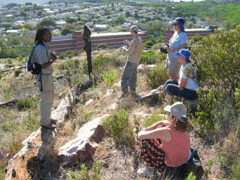
Guide Siphelo Maneli explains baboon behavior as a baboon watched from the treetop. (Photo: Terry FitzPatrick)
CURWOOD: Maneli explains the troupe’s family structure and behavior.
MANELI: You hear the baby go “ah, ah.” The baby wants to have breast feeding.
[BABOONS PLAYING ON WALK]
CURWOOD: Unlike their behavior in the village, the baboons here seem playful and relaxed. They mingle freely with the tourists.
MANELI: You hear that one? That sound means that one wants to mate. And that one is going to go down and mate with this one. And we saw the answer from the calling.
[BABOON MATING CALLS]
CURWOOD: People have been coming on these walks for more than a year to watch baboons doing what comes naturally. Many are overseas tourists. But some, like Bruno Marchand and Anne Manyne, are locals.
MARCHAND: It’s things like this that really put you in touch with where you are. Because we live in an urban environment and yet here is a group of social animals different to us, and they’re doing their thing.
[BABY CHIRPS FOR MILK]

Baboons on the move as monitors drive them from the villages. (Photo: Terry FitzPatrick)
MANYE: When I was a teenager and I was walking in the mountains, we saw baboons all the time and we saw leopards and now there’s nothing. So I’m incredibly pleased that here people are actually keeping them going and, and, make it possible for the baboons to live next to people.
[TOWN CROWD SOUND]
CURWOOD: No one is upset with the presence of baboons in Cape Town’s natural areas. But there’s a growing sense of frustration over the repeated raids on homes.
NOBLE: Okay I think we’re going to start.
CURWOOD: Graham Noble has called a special meeting of the taxpayers association in the village of Scarborough.
NOBLE: Ladies and Gentlemen, welcome. We’ve had a very bad month here in Scarborough with, ah, baboons. We thought May last year it couldn’t get any worse. In fact it got a lot worse. We’re really at our wit’s end to know what is the best thing to do. And that’s why we’ve summoned you here, to discuss the options our community has in facing up to the challenge.
[TOWN MEETING SOUND]
CURWOOD: Many homeowners are angry. Roddy Bray says baboons have ripped-open locks and windows.
BRAY: We now have baboons who are breaking and entering. And I think that the baboons have to be seen as, as rogue elements. If they were humans we would have had them arrested and locked up and sent away.
CURWOOD: The alpha male raiding Scarborough is nick-named “William the Conqueror.” And he’s frightened parents like Pierre de Villiers, who stands in the back of this meeting holding his young son.
DE VILLIERS: This is a boy who’s traumatized. He’s scared to walk outside of our house. This guy William should go.
CROWD: Here, here. Definitely.
DE VILLIERS: He should go because he’s dangerous.
[CROWD DEBATES]
CURWOOD: The idea of killing or relocating the most troublesome animals sparks intense debate. Some residents propose warning sirens or electric fences instead. Others suggest radio collars to track the troupes, and feeding stations inside the park to lure baboons away from people. Many residents though, like Ushka Mrkusic call for calm.
MRKUSIC: I must say that even in my closest encounters, where I’ve been hostage in my kitchen by alpha males, they’ve never damaged me. And if you respond in the moment without making the baboon feel threatened, the baboon will leave without creating any damage. And I think that people are totally overreacting to the situation.
[APPLAUSE]
CURWOOD: Government zoologists say the solution lies more with people than baboons. Urban development in Cape Town is sprawling into wild country, and many homeowners have failed to baboon-proof their property. Some tourists and animal lovers are feeding them handouts. Gavin Bell is the regional wildlife manager for South African national parks.
[CAPE CITY SOUNDS]
BELL: The animals have become familiar with humans. They’re not afraid of humans. And they’ve been fed by humans. Humans have allowed them to move into their houses because they haven’t closed the doors or closed the windows. So they’ve become habituated and familiarized with humans. So what you’ve got to do is you’ve got to break that.
CURWOOD: Wildlife managers are asking for a bigger budget to educate local residents about steps they should take, such as cutting down backyard fruit trees, installing burglar bars on windows and putting locks on garbage cans. Bell says it’s the only long-term solution for living with wildlife.
BELL: Once humans recognize and realize that we’re actually in their place, and that we need to pay proper respect to them, half the battle is won.
[WRANGLING SOUNDS]
CURWOOD: But back in Welcome Glen, as the wranglers struggle to sweep a troupe out of the village, homeowner Carlo Volbrecht isn’t waiting for a long-term solution. He’s giving up.
CURWOOD: I see your house is for sale, anything to do with baboons?
VOLBRECHT: It’s not the only reason, but it’s, we’ve had enough. We’ve got a little one, two years old, and he can’t play in the garden. It’s become unacceptable. So it’s one of the reasons we’re leaving.
[HERDING SOUNDS]
CURWOOD: A few doors down, Denzyl James has a different fear. In the past year, 19 baboons have been shot, run down by cars, poisoned or killed in traps set by residents. It’s illegal to hurt the animals, but James is worried the vigilantes will push local troupes toward extinction.
JAMES: I think we’ve got to look after the baboons. But if they stay in this area, there’r gonna be a lot more fatalities and that’s the sad part. That’s sad.
CURWOOD: There’s not room for people and baboons in the same place, huh?
JAMES: No, that’s the truth.
[WRANGLING SOUNDS]
CURWOOD: Our report on the baboon battle of Cape Town was produced by Living on Earth’s Terry FitzPatrick.
[MUSIC: Ibrahim Ferrer “As Time Goes By” from ‘Rhythms Del Mundo: Cuba!’ (Universal/Ape Vision – 2006)]
Links
Living on Earth wants to hear from you!
Living on Earth
62 Calef Highway, Suite 212
Lee, NH 03861
Telephone: 617-287-4121
E-mail: comments@loe.org
Newsletter [Click here]
Donate to Living on Earth!
Living on Earth is an independent media program and relies entirely on contributions from listeners and institutions supporting public service. Please donate now to preserve an independent environmental voice.
NewsletterLiving on Earth offers a weekly delivery of the show's rundown to your mailbox. Sign up for our newsletter today!
 Sailors For The Sea: Be the change you want to sea.
Sailors For The Sea: Be the change you want to sea.
 The Grantham Foundation for the Protection of the Environment: Committed to protecting and improving the health of the global environment.
The Grantham Foundation for the Protection of the Environment: Committed to protecting and improving the health of the global environment.
 Contribute to Living on Earth and receive, as our gift to you, an archival print of one of Mark Seth Lender's extraordinary wildlife photographs. Follow the link to see Mark's current collection of photographs.
Contribute to Living on Earth and receive, as our gift to you, an archival print of one of Mark Seth Lender's extraordinary wildlife photographs. Follow the link to see Mark's current collection of photographs.
 Buy a signed copy of Mark Seth Lender's book Smeagull the Seagull & support Living on Earth
Buy a signed copy of Mark Seth Lender's book Smeagull the Seagull & support Living on Earth

